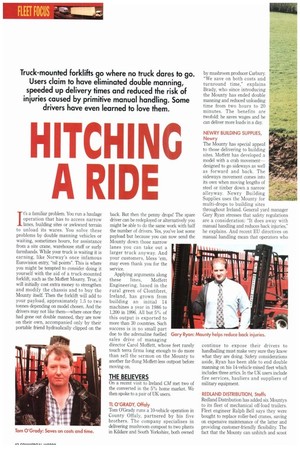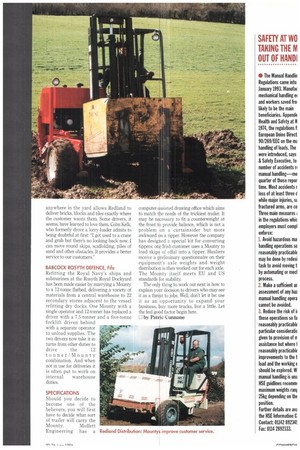HITCHING A RIDE
Page 44

Page 45

If you've noticed an error in this article please click here to report it so we can fix it.
It's a familiar problem. You run a haulage operation that has to access narrow lanes, building sites or awkward terrain to unload its wares. You solve these problems by double manning vehicles or waiting, sometimes hours, for assistance from a site crane, warehouse staff or surly farmhands. While your truck is waiting it is earning, like Norway's once infamous Eurovision entry, "nil points". This is where you might be tempted to consider doing it yourself with the aid of a truck-mounted forklift, such as the Moffett Mounty. True, it will initially cost extra money to strengthen and modify the chassis and to buy the Mounty itself. Then the forklift will add to your payload, approximately 1.5 to two tonnes depending on model chosen. And the drivers may not like them—where once they had gone out double manned, they are now on their own, accompanied only by their portable friend hydraulically clipped on the
back. But then the penny drops! The spare driver can be redeployed or alternatively you might be able to do the same work with half the number of drivers. Yes, you've lost some payload but because you can now send the Mounty down those narrow lanes you can take out a larger truck anyway. And your customers, bless gem, may even thank you for the service.
Applying arguments along these lines, Moffett Engineering, based in the rural green of Clontibret, Ireland, has grown from building an initial 14 machines a year in 1986 to 1,200 in 1996. All but 5% of this output is exported to more than 30 countries. Such success is in no small part due to the adrenaline fuelled sales drive of managing director Carol Moffett, whose feet rarely touch terra firma long enough to do more than sell the sermon on the Mounty to another far-flung Moffett-less outpost before moving on.
On a recent visit to Ireland CM met two of the converted in the 5% home market. We then spoke to a pair of UK users.
Tom O'Grady runs a 10-vehicle operation in County Offaly, partnered by his five brothers. The company specialises in delivering mushroom compost to two plants in Kildare and South Yorkshire, both owned by mushroom producer Carbury "We save on both costs and turnround time," explains Brady, who since introducing the Mounty has ended double manning and reduced unloading time from two hours to 20 minutes. The benefits are twofold: he saves wages and he can deliver more loads in a day.
NEWRY BUILDING SUPPLIES, Newry
The Mounty has special appeal to those delivering to building sites. Moffett has developed a model with a crab movement— designed to go sideways as well as forward and back. The sideways movement comes into its own when moving lengths of steel or timber down a narrow alleyway. Newry Building Supplies uses the Mounty for multi-drops to building sites throughout Ireland. General yard manager Gary Ryan stresses that safety regulations are a consideration: "It does away with manual handling and reduces back injuries," he explains. And recent EU directives on manual handling mean that operators who
continue to expose their drivers to handballing must make very sure they know what they are doing. Safety considerations aside. Ryan has been able to end double manning on his 14-vehicle mixed fleet which includes three artics. In the UK users include fire services, hauliers and suppliers of military equipment.
REDLAND DISTRIBUTION, Staffs
Redland Distribution has added six Mountys to its fleet of mechanical off-load trailers. Fleet engineer Ralph Bell says they were bought to replace roller-bed cranes, saving on expensive maintenance of the latter and providing customer-friendly flexibility. The fact that the Mounty can unhitch and scoot anywhere in the yard allows Redland to deliver bricks, blocks and tiles exactly where the customer wants them. Some drivers, it seems, have learned to love them. Colm Kelk, who formerly drove a lorry-loader admits to being doubtful at first: "1 got used to a crane and grab but there's no looking back now. I can move round skips, scaffolding, piles of sand and other obstacles. It provides a better service to our customers."
BABCOCK ROSYTH DEFENCE, Fife Refitting the Royal Navy's ships and submarines at the Rosyth Royal Dockyard has been made easier by marrying a Mounty to a 12-tonne flatbed, delivering a variety of materials from a central warehouse to 22 secondary stores adjacent to the vessel refitting dry docks. One Mounty with a single operator and 12-tonner has replaced a driver with a 7.5-tonner and a five-tonne forklift driven behind with a separate operator to unload supplies. The two drivers now take it in turns from other duties to drive the 12 tonner/Mounty combination. And when not in use for deliveries it is often put to work on internal warehouse duties.
SPECIFICATIONS Should you decide to become one of the believers, you will first have to decide what sort of trailer will carry the Mounty. Moffett Engineering has a
computer-assisted drawing &ice which aims to match the needs of the trickiest trailer. It may be necessary to fit a counterweight at the front to provide balance, which is not a problem on a curtainsider but more awkward on a tipper. However the company has designed a special kit for converting tippers: one Irish customer uses a Mounty to load skips of offal into a tipper. Hauliers receive a preliminary questionnaire on their equipment's axle weights and weight distribution is then worked out for each axle. The Mounty itself meets EU and US standards for stability.
The only thing to work out next is how to explain your decision to drivers who may see it as a threat to jobs. Well, don't let it be: use it as an opportunity to expand your business, buy more trucks, live a little. Let the feel-good factor begin here.
0 by Patric Cunnane
















































































































